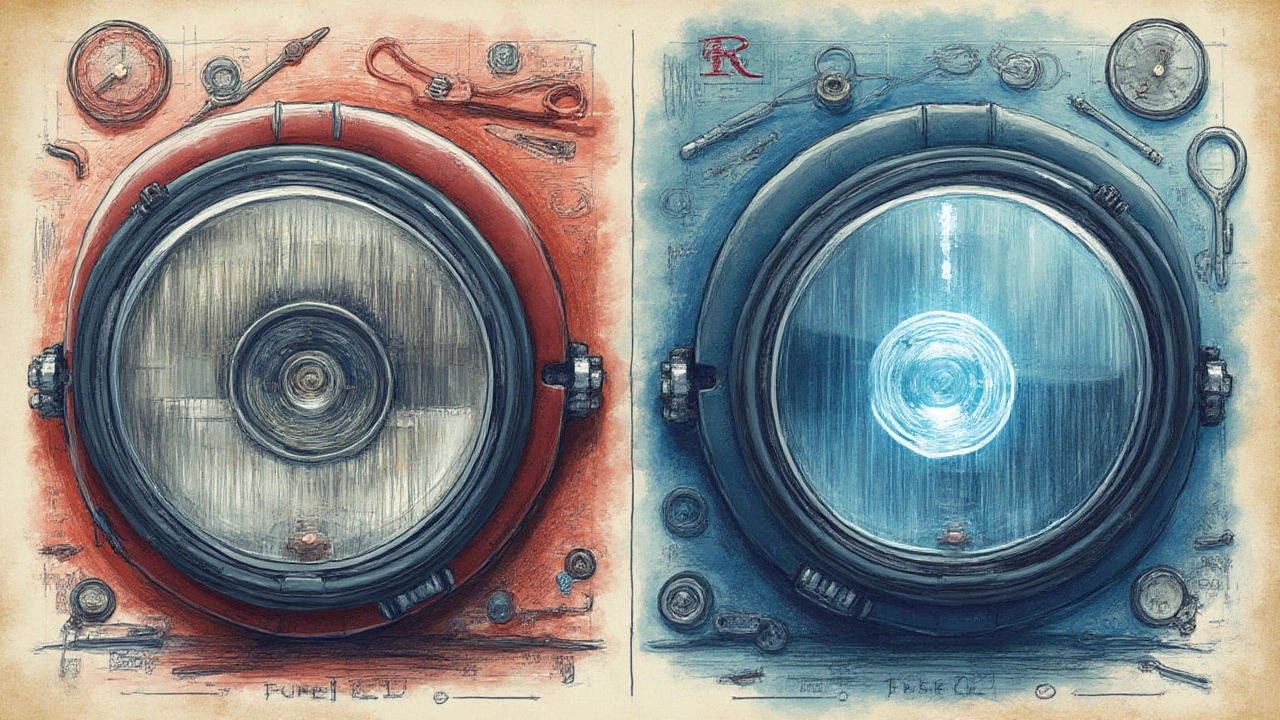Picture this: you’re driving up Glen Osmond Road at night and the dim beams from your old car’s headlights barely light the tarmac ahead. In the age of blindingly bright modern vehicles, those yellowy halogens in your old headlights hardly cut it. Enter LED bulbs—the shining promise of better visibility, lower power use, and a modern dash of style. But swapping out old halogen bulbs for LEDs? That’s not as simple as yanking out the old and plugging in the new. There’s a bunch of myths, some facts that’ll surprise you, and yes—a few legal curveballs that might just get you in trouble if you don’t do it right.
Why Drivers Consider LED Headlights for Old Cars
Most folks don’t bother with headlight upgrades until their old lights really start to fade. Halogen bulbs, which have been around since the 1960s, do the job, but they lose brightness over time, and that yellow tinge barely compares to the crisp white glow of LEDs. In fact, halogen bulbs in old headlights tend to give off about 1,000 to 1,500 lumens of light, while a good-quality LED bulb can easily hit 4,000 lumens. That’s almost triple the brightness, all while using less energy and promising much longer life—some LED bulbs are rated north of 30,000 hours, while halogens start fizzling after 500 to 1,000 hours. Cost-wise, LEDs are pricier upfront, but because they last longer, you’ll rarely have to change them.
It’s not just about brightness, though. Drivers love the clean, modern look that LEDs provide—no more muddy yellow pools on the road. Plus, there’s a bit of practical appeal: most vehicles on the road are running halogens, but with LEDs, other drivers see you coming a lot sooner. That’s some pretty solid peace of mind, especially on those country roads outside Adelaide, where roos and possums can jump out unexpectedly. And hey, if you’re into keeping your battery happy, LED bulbs run so efficiently that they barely strain your car’s system, leaving more juice for everything else—especially in older rides where alternators are already working overtime.
If you’re considering the swap, chances are you want more than just a cosmetic tweak. Maybe you’ve seen headlight comparison videos where LEDs turn night into almost-day, or maybe you’ve spent time behind the wheel of a mate’s car with LEDs. That’s the thing: seeing truly is believing. Yet, as tempting as it is, there’s more than meets the eye with this swap.
How LED Bulbs Work in Old Headlight Housings
Here’s the tricky part—slapping LED bulbs into old halogen housings isn’t a one-size-fits-all deal. Halogen bulbs throw light in a certain way, and old reflector housings (the classic design before about 2014) are made to spread that light pattern safely onto the road. LEDs are incredibly bright, but they focus that light differently, and that can cause problems. The classic symptom? Glare. Bad glare. If the bulb or the optic geometry isn’t right, you wind up blinding everyone in oncoming traffic, or worse, you can’t see much of the road yourself.
The reason? LEDs emit light from a flat surface, while halogens glow from a small filament. Reflectors are carefully shaped for filaments, not LED chips. Put a powerful LED into a headlamp built for halogen, and the beam pattern shifts—sometimes up, sometimes sideways, but rarely how it should. A 2024 survey from the Australian Road Research Board (ARRB) found that, in poorly matched reflector housings, 62% of aftermarket LED conversions produced more glare than the original halogens, and their throw distance (how far you can see down the road) could actually be worse than stock if the bulb isn’t designed correctly.
What’s more, many of the LED kits you find online are one-size-fits-all, but old headlights come in dozens of shapes—H4, H7, 9005, and more, all with different reflector designs. Sometimes, the result is a scattered mess. It’s possible to get excellent results, though, if you pick a high-quality bulb with a chip layout that mimics a filament, and you match it precisely to your headlight’s socket type. Some premium LED kits include adjustable bases and fine-tuned optics for classic reflectors, but they cost more—usually $120 to $250 AUD per pair, compared to $20 halogens. If you’re hoping to do this upgrade, don’t expect miracles from the generic $30 kits off eBay or Amazon.

Road Legality and Safety Issues in Australia
This is where folks often get caught out: swapping to LED bulbs in original halogen headlights is technically illegal in most Australian states unless the headlamp and bulbs are certified together as street-legal by the manufacturer. That’s tucked away in the Australian Design Rules (ADR 46/00, for those who want to know). The reason’s simple: authorities worry about poor beam focus, dazzle for oncoming drivers, and the fact that headlights are vital for everyone’s safety, not just yours. You might get away with it for years, but if you’re in a crash, insurance assessors can—and sometimes will—flag your lighting as modified, which could void claims. South Australia’s rego (registration) checks, known as the “roadworthy,” don’t always spot illegal bulbs, but if cops pull you over for “dazzling” lights, you can cop a defect notice, meaning a headache just to get back on the road.
There’s a small loophole, though. Some companies sell full LED headlamp assemblies that come certified for road use (usually listed as ‘E-marked’ or ‘ADR-approved’). These replace the whole headlight unit—not just the bulb—and that’s perfectly legal as long as the assembly is labeled as compliant. These setups aren’t cheap, but they’re the surest way to modernize your lighting and stay above board. If you’re planning to upgrade an old Pajero, Commodore, or Corolla, it’s wise to check if ADR-approved LED assemblies are available before you splash out on bulbs alone. If none exist for your model, stick with premium halogen replacements or look for LED bulbs that at least carry international certifications (like ECE R112), though these aren’t strictly Australia-approved.
Want some numbers? According to 2023 NSW Police data, defective lighting was a factor in about 4% of defect notices issued to passenger vehicles. It’s not super common, but it happens, and enforcement is on the rise as more cheap LEDs flood the market. The best advice: always check local regs before you buy and use high-quality, well-matched kits if you decide to go the route of LED bulbs in old headlights.
Step-by-Step: Installing LED Bulbs the Right Way
If you’re still set on making the upgrade, do a bit of homework first. Smart LED conversions pay off when you follow best practices:
- Check compatibility — Find out your car’s bulb type (check the handbook or the old bulb itself). Only buy LEDs specifically made for that socket and reflector design. Don’t gamble on “universal” fits.
- Opt for premium brands — Names like Philips, Osram, and Narva invest in precise LED chip placement, so the beam pattern closely mimics halogens. Look for kits with reviews and beam comparison tests, not just pretty photos.
- Do a test fit — Install the LED in one side before sealing everything up. Park about 5 metres from a wall, switch on the low beam, and compare the light pattern and cutoff to the halogen side. A crisp horizontal line (the cutoff) is vital—you want minimal scatter or “hot spots.”
- Check for CANbus errors — Some newer cars (post-2012, common in Mazdas and Hyundais) have bulb warning systems. Cheap LEDs may trigger bulb fault errors, or even cause flickering. Go for kits labeled as “CANbus compatible” if your car is newer.
- Secure cooling fans — Many LED designs have tiny cooling fans or heat sinks. Make sure yours clear the rear of the headlight housing, especially on older Aussie cars with cramped engine bays.
- Do a nighttime road test — With any LED retrofit, hit a dark road and check for oncoming glare, insufficient side spread, or patchy light right in front of you. Bring a mate to help check from outside—what looks good behind the wheel can dazzle others.
- Adjust your aim — If your car has adjustable headlights, consider lowering them slightly to offset the extra brightness. This helps keep you onside with the law and your fellow drivers.
- Keep your halogen bulbs — Seriously, hang onto them. If you ever need to swap back for rego inspection or if you travel interstate, you’ll want to restore the car to stock in minutes.
Most importantly, don’t force anything. Some old reflectors have fragile plastic clips or rubber seals that crack easily with age—no sense saving time if it means breaking parts no longer made for your classic Ford or Holden. And always double-check you haven’t left wiring exposed, as LED driver modules can short if water gets in. This step-by-step approach helps ensure your DIY upgrade is safe, effective, and as legal as possible.

What Sets Quality LED Bulbs Apart? (And Common Pitfalls to Dodge)
Not all LED bulbs are created equal. Some “super-bright” kits from budget stores or auction sites can look good online but fail horribly in practice. Here’s a table comparing the main differences:
| Feature | Cheap LED Kits | Premium LED Kits |
|---|---|---|
| Chip type | Generic, often inconsistent | Automotive specific, precise layout |
| Beam pattern | Scattered, lots of glare | Controlled, close to halogen |
| Colour temperature | Overly blue (6000K+) | ,Natural white (4300K-5500K) |
| Build quality | Plastic, cheap wiring | Metal bodies, sealed connectors |
| Cooling | Basic, often no fan | Active cooling with heat sinks, fans |
| Warranty | 3-6 months (if any) | 12-24 months |
| ADR/ECE certified? | No | Sometimes, check before buying |
The biggest trap? Going “too blue” with light colour—modern car headlights usually sit around 4300K to 5500K on the colour temperature scale, which looks white but is still easy on the eyes. Anything above 6000K goes into the blue spectrum, which looks cool on paper but causes more glare for you and others, and can attract police attention. Stick to something that mimics daylight for both style and safety.
It’s tempting to chase the biggest wattage numbers or the highest lumen claims—don’t. Many cheap kits inflate those figures, or cram in so many LEDs that the chips overheat and fail early. The best-marketed LEDs match the brightness of your car’s design, don’t blind other drivers, and won’t cook their drivers or lenses over time. Chasing bargains can mean you spend more in the long-term swapping failed bulbs or getting hassled at rego—paying for quality up front is the smarter move.
Watch out for moisture, too. Cheaper bulbs often lack proper seals, and a rainy night run through the hills can fog up your headlight internals, permanently hazing up the lens. Quality manufacturers seal their modules, use weatherproof drivers, and give you reassurance against those classic “Ozzy weather” moments.
Finally, beware the “instant upgrade” promise. A well-installed LED can be a big win, but a poor fit is a headache. Always check reviews, look for real output photos (not just digitally enhanced marketing shots), and favour brands with Aussie support, in case you need help or local compliance documentation down the line.